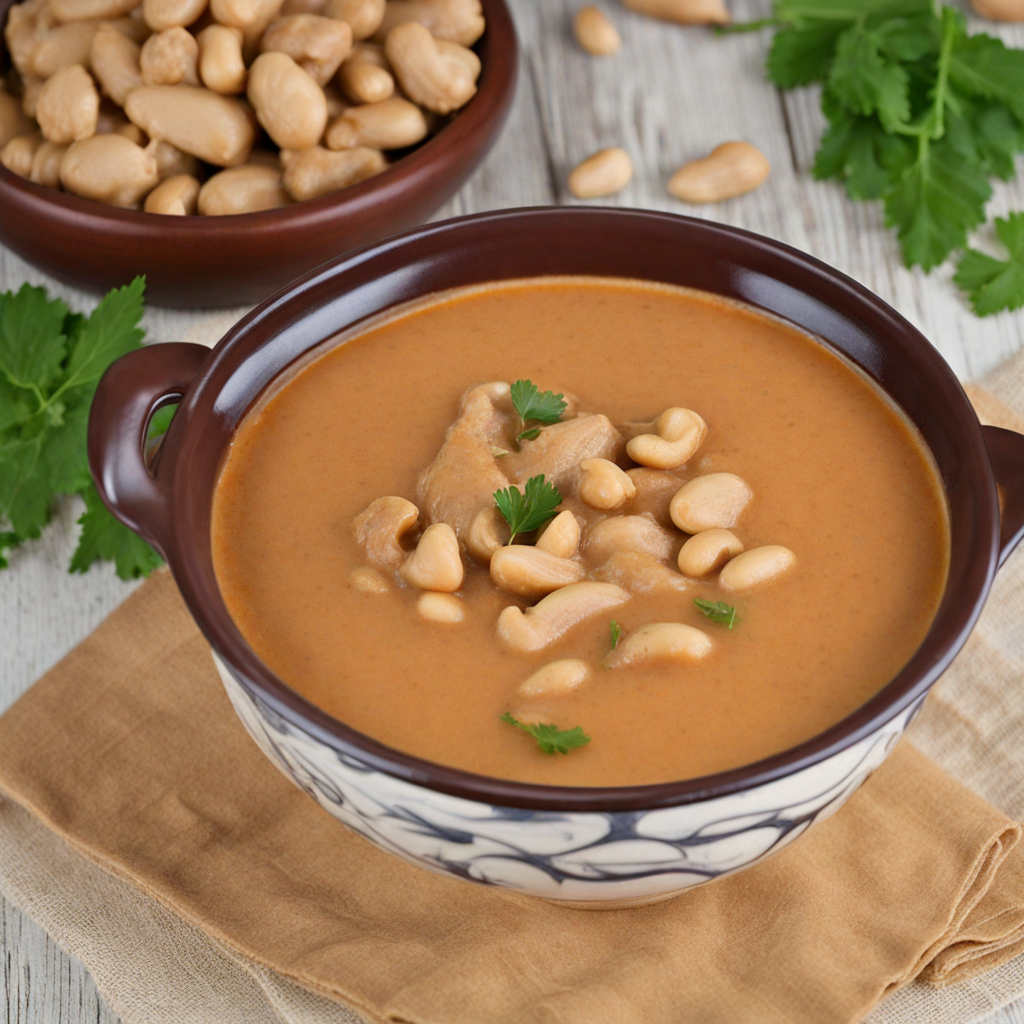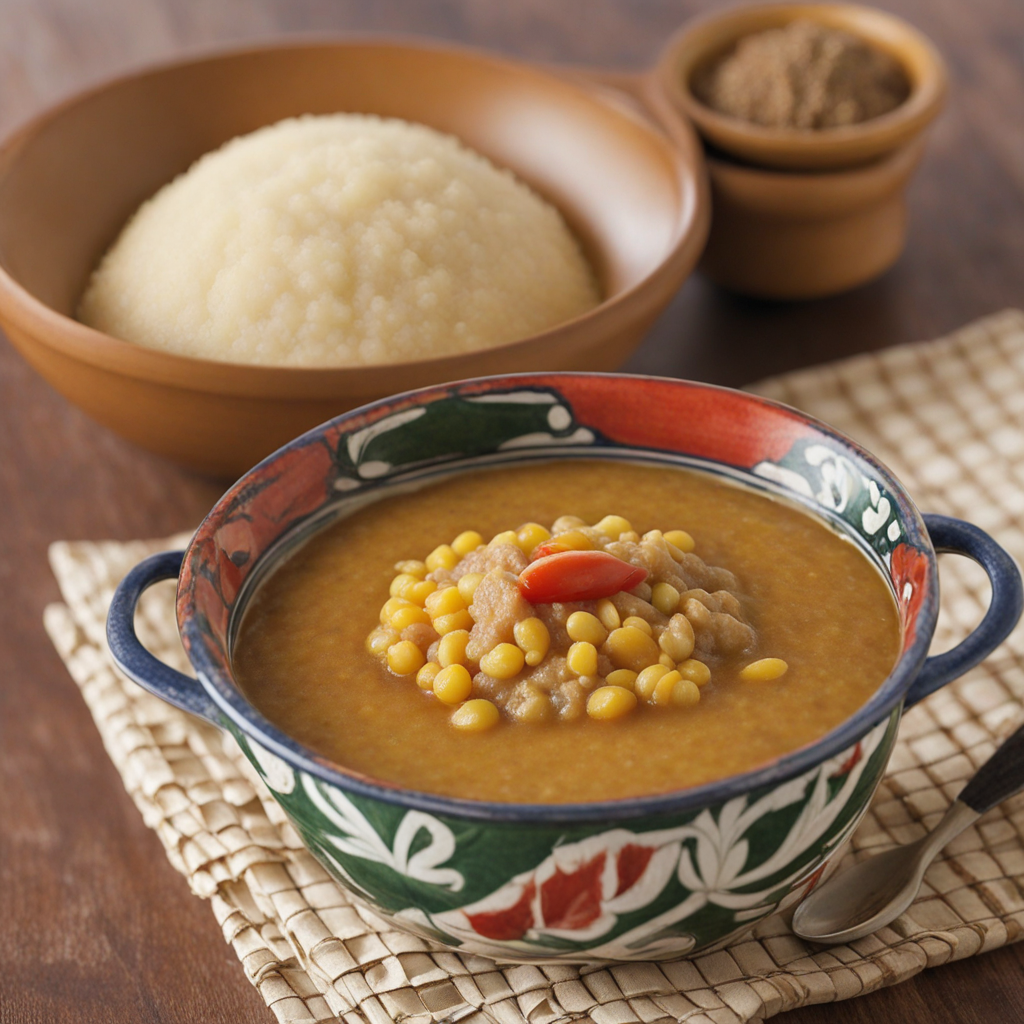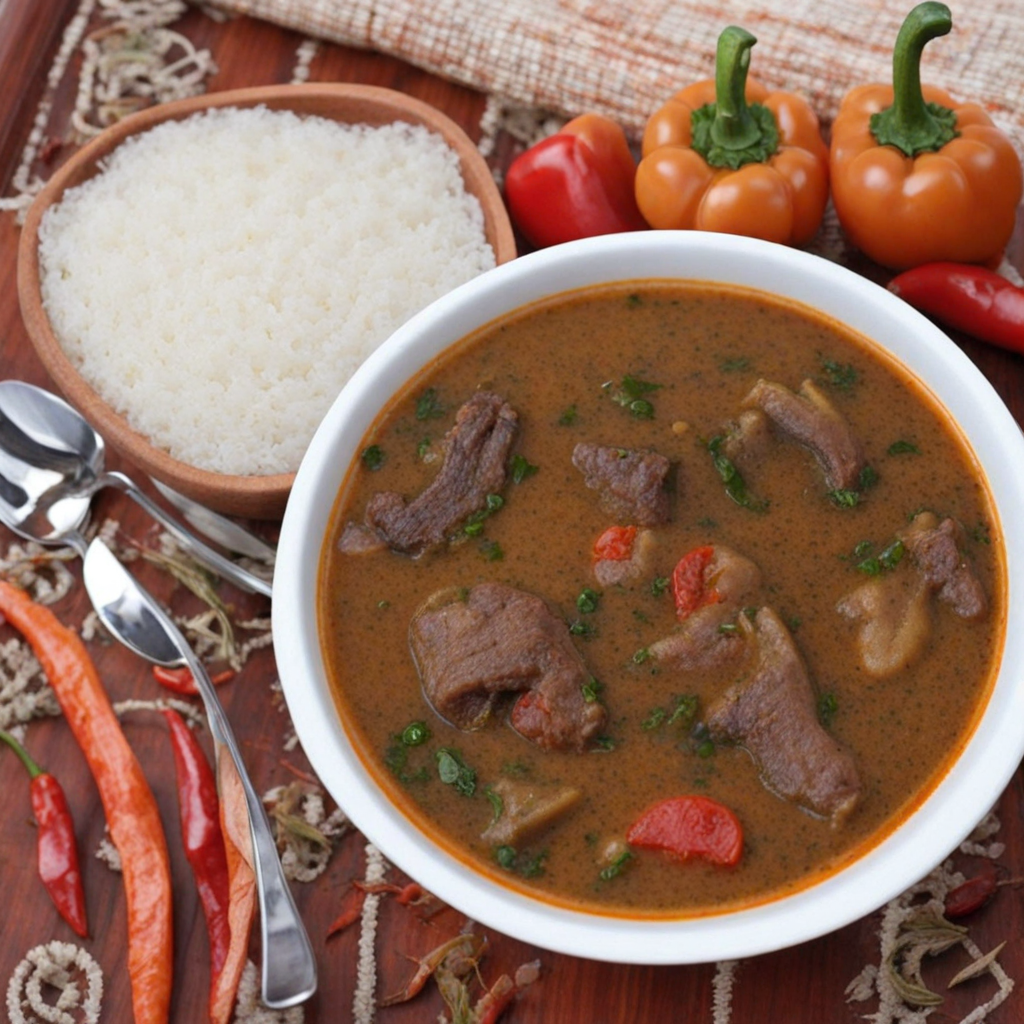Groundnut Soup
Groundnut Soup, a beloved dish from Guinea, offers a rich and creamy experience that tantalizes the taste buds. At its heart, this soup features groundnuts, also known as peanuts, which are ground into a smooth paste and combined with a variety of aromatic spices. The blend of ingredients often includes tomatoes, onions, and garlic, creating a savory base that enhances the nutty flavor of the groundnuts. The result is a velvety soup that envelops you in warmth and comfort, making it a popular choice for both family meals and festive occasions. One of the unique aspects of Groundnut Soup is its versatility. While the traditional recipe showcases the simplicity of groundnuts and spices, many cooks add their own twist by incorporating vegetables, meats, or fish. Common additions include chicken, beef, or even leafy greens, which contribute to the dish's hearty nature. Each variation brings a new depth of flavor, allowing you to discover a different taste with every bowl. This adaptability not only makes the soup enjoyable but also highlights the creativity and resourcefulness of Guinean cuisine. The experience of savoring Groundnut Soup is as much about the aroma as it is about the flavor. As the soup simmers, the enticing scents waft through the air, inviting you to indulge. When served, it is often accompanied by a side of rice or fufu, which perfectly complements the rich, nutty broth. Each spoonful is a harmonious blend of textures and tastes, making Groundnut Soup a culinary adventure that reflects the warmth and hospitality of Guinean culture. Whether you're looking to explore new flavors or simply enjoy a comforting meal, this soup is sure to leave a lasting impression.
How It Became This Dish
Soupe de Cacahuète: A Culinary Journey from Guinea #### Origins Soupe de Cacahuète, or Peanut Soup, is a cherished dish from Guinea, a West African nation renowned for its diverse culinary heritage. The origins of this flavorful soup can be traced back to the introduction of peanuts to Africa, believed to have arrived from South America through the trans-Atlantic slave trade in the 16th century. The peanut, known for its adaptability and nutritional value, quickly became a staple crop in various African countries, including Guinea. In the fertile regions of Guinea, particularly along the banks of the Niger River and in the forested areas, peanuts thrived due to the rich soil and favorable climate. The local communities began to incorporate peanuts into their diets, utilizing them not just as a snack but also as a key ingredient in a variety of dishes. This adaptability was crucial in the development of Soupe de Cacahuète, which integrates peanuts into a hearty, flavorful soup that reflects the agricultural bounty of the region. #### Cultural Significance Soupe de Cacahuète is more than just a dish; it embodies the spirit and resilience of Guinean culture. Traditionally served during family gatherings, celebrations, and communal meals, this soup symbolizes hospitality and togetherness. In a society where communal eating is a significant aspect of social interaction, Soupe de Cacahuète fosters connections among family members and friends. The preparation and sharing of the soup often involve multiple generations, with recipes being passed down and adapted over time. Peanuts are not only a source of sustenance but also hold cultural significance. They are associated with prosperity and fertility in many African cultures. In Guinea, peanut festivals celebrate the harvest, and dishes like Soupe de Cacahuète take center stage during these events, showcasing the importance of peanuts in local agriculture and gastronomy. The soup is often accompanied by rice or fufu, further enhancing its role as a nourishing and fulfilling meal during significant events. #### Ingredients and Preparation The beauty of Soupe de Cacahuète lies in its simplicity and versatility. The key ingredient, ground peanuts, provides a creamy texture and a rich, nutty flavor. The soup is typically made with a base of onions, tomatoes, and spices such as garlic, ginger, and chili peppers, reflecting the vibrant flavors of West African cuisine. Depending on the region and personal preferences, variations of the soup might include vegetables like spinach, carrots, or sweet potatoes, as well as proteins such as chicken, fish, or beef. To prepare Soupe de Cacahuète, the peanuts are often toasted and then ground into a fine paste, which is then mixed with water to create a smooth consistency. Onions and tomatoes are sautéed together, forming a fragrant base for the soup. The ground peanut mixture is added, along with any choice of protein and vegetables. The ingredients are simmered until well combined, allowing the flavors to meld and the soup to thicken. The result is a hearty, comforting dish that is both filling and nutritious. #### Development Over Time As Guinea has undergone various social and economic changes, so too has the preparation and consumption of Soupe de Cacahuète. In the past, this dish was primarily prepared in rural areas, where ingredients were sourced from local farms and markets. However, with the increasing urbanization of Guinea’s population, the accessibility of ingredients has expanded. Urban dwellers now enjoy Soupe de Cacahuète in restaurants and street food stalls, often with modern twists that cater to evolving tastes. The globalization of food culture has also influenced Soupe de Cacahuète. While traditional recipes remain popular, chefs and home cooks have begun to experiment with new ingredients and presentation styles, merging traditional flavors with contemporary culinary techniques. For instance, some chefs may incorporate local Guinea spices or unique garnishes, enhancing the soup's visual appeal while maintaining its authentic flavor profile. #### International Recognition In recent years, Soupe de Cacahuète has gained international recognition, thanks in part to the growing interest in African cuisines globally. Food enthusiasts and chefs have begun to explore and celebrate the flavors of West Africa, introducing dishes like Soupe de Cacahuète to a broader audience. Cookbooks, food blogs, and culinary shows have played a significant role in showcasing this dish, emphasizing its unique ingredients and rich cultural heritage. The dish's popularity has also been bolstered by the increasing awareness of the nutritional benefits of peanuts. Rich in protein, healthy fats, and various vitamins and minerals, Soupe de Cacahuète is not only delicious but also a wholesome option for those seeking nutritious meals. As health-conscious eating trends continue to rise, Soupe de Cacahuète stands out as an appealing choice for individuals looking to explore global flavors while maintaining a balanced diet. #### Conclusion Soupe de Cacahuète is more than just a meal; it is a reflection of Guinea’s agricultural history, cultural traditions, and evolving culinary landscape. From its origins in the introduction of peanuts to its status as a beloved dish today, Soupe de Cacahuète encapsulates the essence of community, resilience, and the rich tapestry of flavors that define Guinean cuisine. As this dish continues to evolve and gain recognition on the global stage, it bridges the gap between traditional culinary practices and contemporary food culture. Whether enjoyed in a bustling urban restaurant or a quiet family gathering, Soupe de Cacahuète remains a testament to the enduring legacy of Guinea’s culinary heritage, inviting food lovers to savor its rich, nutty flavors and the stories woven into each bowl.
You may like
Discover local flavors from Guinea







